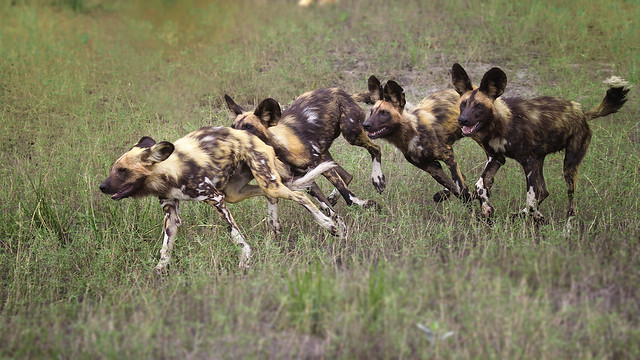An endangered species, Lycaon pictus is a canid found only in Africa, especially in savannas and lightly wooded areas. It is variously called the African wild dog, African hunting dog, Cape hunting dog, African painted dog, painted wolf, painted hunting dog, spotted dog, or ornate wolf. I had an excellent opportunity to see these magnificent creatures for a long time when we were in Botswana. Spending almost 4 hours with the pack as they went about their business.
I got a whole lot of photos but this particular one of young adults galavanting around after a meal has a dynamic quality which i particularly loved. Unfortunately the species in under a threat due to various reasons.
Distribution and threats
The home range of packs varies depending on the size of the pack and the nature of the terrain. In the Serengeti, the average dog density (prior to the local extinction of the species) was one dog per 208 km2 (80 sq mi), whereas in the Selous Game Reserve, the average density was one dog every 25 km2 (9.7 sq mi). However, the population density in the Serengeti as late as 1970 was as high as one dog per 35 km2 (14 sq mi) before falling to one in 200 km2 (77 sq mi) in 1977. Their preferred habitat in the Serengeti is deciduous woodlands because of large prey herd size, lack of competition from other carnivores, and better sites for denning. In the Serengeti, the average range has been estimated at 1,500 square kilometres (580 sq mi), although individual ranges overlap extensively.
Once, about 500,000 African wild dogs existed in 39 countries, and packs of 100 or more were not uncommon. This range once included Egypt and parts of the Sahara Desert.Now, only about 3,000–5,500 are found in fewer than 25 countries, or perhaps only 14 countries. They are primarily found in eastern and southern Africa, mostly in the two remaining large populations associated with the Selous Game Reserve in Tanzania and the population centered in northern Botswana and eastern Namibia. Smaller but apparently secure populations of several hundred individuals are found in Zimbabwe (Hwange National Park), South Africa (Kruger National Park), and in the Ruaha/Rungwa/Kisigo complex of Tanzania. Isolated populations persist in Zambia, Kenya, and Mozambique.
The African wild dog is an endangered species due to habitat loss and poaching. It uses very large territories (so can persist only in large wildlife protected areas), and it is strongly affected by competition with larger carnivores that rely on the same prey base, particularly the lion and the spotted hyena. While the adult wild dogs can usually outrun the larger predators, lions often will kill as many wild dogs and cubs at the brooding site as they can, but do not eat them. One-to-one, the hyena is much more powerful than the wild dog, but a large group of wild dogs can successfully chase off a small number of hyenas because of their teamwork. It is also killed by livestock herders and game hunters, though it is typically no more (perhaps less) persecuted than other carnivores that pose more threat to livestock. Most of Africa’s national parks are too small for a pack of wild dogs, so the packs expand to the unprotected areas, which tend to be ranch or farm land. Ranchers and farmers protect their domestic animals by killing the wild dogs. Like other carnivores, the African wild dog is sometimes affected by outbreaks of viral diseases such as rabies, distemper, and parvovirus. Although these diseases are not more pathogenic or virulent for wild dogs, the small size of most wild dog populations makes them vulnerable to local extinction due to diseases or other problems.
Ref: https://en.wikipedia.org/wiki/Lycaon_pictus#Social_structure
